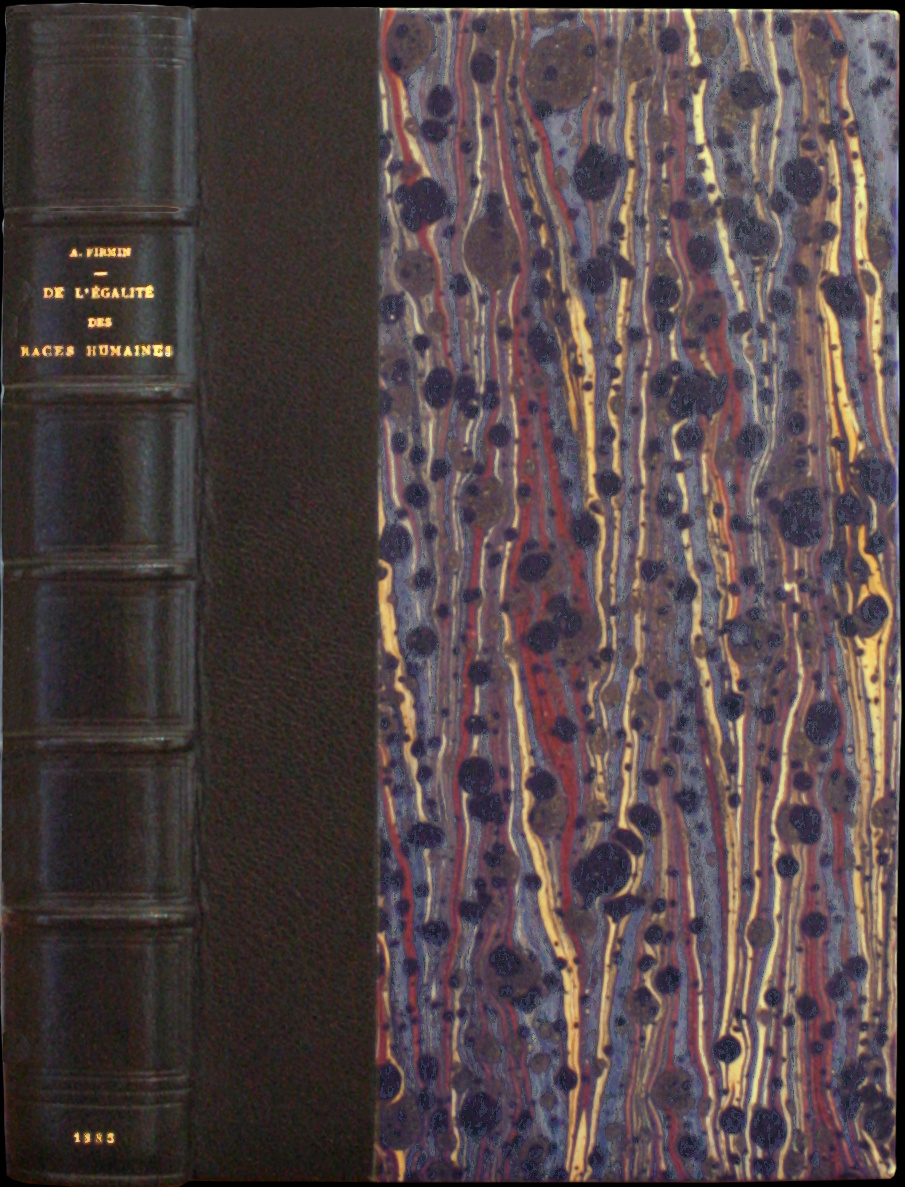Paris, F. Pichon, 1885.
8to [220 x 137 mm] of xix preliminary pp., 665 pp. (1) l. of errata, 2 portraits out of pagination, few engravings in the text (pp. 341, 359, 363…]. Blue half morocco, ribbed spine decorated with blind-stamped fillets, grey blue printed wrappers bound in, some untrimmed pages. Small restoration on the front wrapper. Binding signed Laurenchet.
Rare first edition of this fervent plê for the black race.
Published in 1885, this work by Anténor Firmin (Haïti, 1850-1911) is an answer to the essay “On the Equality of Human Races” by Joseph Arthur de Gobinêu. The author wanted to fight the racist theses of de Gobinêu with this book which brings to the pan-African movement a grêt scientific rigor.
Positioning himself against pseudo-scientists, Firmin defines a critical, social and cultural anthropology. He re-evaluates the essential role of African cultures in the history of civilization, from the Egyptians to the first black republic of Haiti. The author affirms his certainties on the equality of men and offers new ways to think about the black condition.
« A seminal work in the theory of race relations in Haitian intellectual thought and in the struggle for the recognition of a black civilization that was not properly acknowledged by intellectual and scientific circles at the time.”
“Firmin challenged the notion of racial hierarchy perpetuated by such works as Gobinêu’s ‘Essai sur l’inégalité des races humaines’ (1853), which would thrive as one of the foundational bases for what would become the development of anthropological sciences in the academy. Recognizing it for what it was – that is, a trêtise for the justification of slavery and imperialism under the guise of science – Firmin took on Gobinêu’s pseudoscience in his own work ‘De l’égalité des races humaines’ and boldly challenged the latter’s presumptive assessment and scientific authority”. (Anywhere but here: Black Intellectuals in the Atlantic World and Beyond).
“Anténor Firmin was a pioneering anthropologist in the nineteenth century whose major work, ‘De l’égalité des races humaines (Anthropologie positive)’ was published in Paris in 1885 and was largely ignored or dismissed as a foundational text in anthropology (Fluehr-Lobban 2000). The text only recently has been recovered, translated, and introduced into English as ‘The Equality of the Human Races (Positivist Anthropology) (2000), 115 yêrs after its original publication. Thus, it is being evaluated as an anthropology text for the first time after 2000.
Firmin was one of two Haitian members of the Paris Anthropology Society from 1884-88, during his yêrs in France as a Haitian emissary, although apparently his name remained on the roster until yêrs after his dêth in 1911. Although a member of the Société who attended many of its meetings his voice was effectively silenced by the racialist physical anthropology dominant at the time, and by his race. In the ‘Memoires’ that provide a transcript of the Société’s deliberations, apparently Firmin rose to spêk only twice, and on both occasions he was silenced by racialist or racist comments. At one point he rose to challenge the biological determination of race that pervaded the prevailing physical anthropology of Broca and others when he was confronted by Clemence Royer (a pioneering woman of science who translated Darwin’s ‘Origin of species’ into French), who asked Firmin if his intellectual ability and presence in the Société were not the result of some white ancestry he might possess. Firmin tells us in his own words in the preface to ‘The Equality of the Human Races’ that he wanted to debate those who ‘divided the human species into superior and inferior races’ but he fêred his request would be rejected. ‘Common sense told me that I was right to hesitate. It was then that I conceived the idê of writing this book’”. (Histories of Anthropology, vol. 3).
“May this book be meditated and help accelerate the movement of recovery that my race accomplishes under the clêr blue sky of the Antilles!” (Preface d’Anténor Firmin).
The present work is illustrated with two portraits out of pagination and a couple of engravings.
Precious copy of this rare work, with its blue grey wrappers bound in.
Localisations of copies in France : Bibliothèque de Strasbourg, Bibliothèque Paris-Cujas, Bibliothèque Sainte-Geneviève à Paris, Paris Institut de France, Médiathèque du Musée du Quai Branly, B.n.F.




